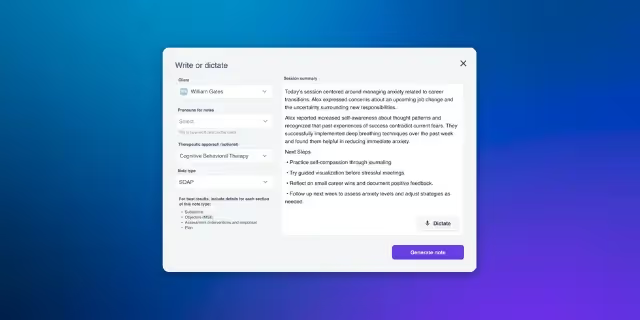A clinician's guide to therapy billing

Therapy billing — the thing that actually gets you paid — shouldn't take up as much time as seeing your clients. The truth is that your extensive clinical training didn't cover how to get paid. Far too many therapists risk burnout by spending up to 40% of their time working on therapy bookkeeping. Streamlined options could take care of it for a fraction of the effort.
In this post, we demystify therapy billing. We’ll also break down tips for speeding up payment and reducing your stress load.
We’ll talk about cash vs. insurance for therapists, CPT, and ICD-10 codes. We’ll also review the top billing platforms for therapists. We’ll dig into other topics that are bottlenecking your profitability and productivity.
Key takeaways:
- Work–life balance is the strongest predictor of emotional exhaustion for therapists. It’s also a cause of depersonalization among psychotherapists.
- Many therapists don't know how to stop burnout. It’s often tied to administrative and billing duties. These can result in long working hours.
- Therapists can decide on a cash-pay, insurance-only, or hybrid practice model for billing. This should be based on their goals for practice growth.
- Therapists can choose between do-it-yourself billing, third-party billing, and all-in-one billing platforms. All have their own pros and cons.
- All-in-one billing is the only option that merges various things with billing. These include billing codes, client notes, HIPAA compliance, CAQH profiles, and NPI numbers.
What is the best billing model for therapists? Choosing cash, insurance, or both
Your choice to accept cash or insurance as a therapist drives your business model and growth potential. You can choose cash pay, insurance, or both. Understanding the trade-offs of each option will help you choose the right model for your needs.
Cash-pay model pros and cons
According to the American Psychological Association (APA), 34% of psychologists don't accept insurance. Why do some therapists choose not to take insurance? The biggest factor is insufficient reimbursement rates, say 82% of therapists (APA). Then 62% cite administrative challenges. Around 52% point to concerns about payment delays.
Here's a look at the benefits and downsides of a cash-only therapy practice.
👍 Cash-pay model pros:
- You set your own rates.
- There's no insurance approval or paperwork to submit.
- Clients enjoy greater privacy from their employers and family members.
- More autonomy for diagnosis and treatment.
👎 Cash-pay model cons:
- The client pool is limited to those who choose/can afford cash.
- You may be stuck creating superbills. These have ICD-10 and CPT codes, service dates, and payment totals. This can occur if a client seeks reimbursement through out-of-network or flexible spending.
Insurance-based model pros and cons
The best billing model for therapists, if you want access to a wider client pool, is insurance. Taking insurance widens earning potential for those willing to handle extra administrative work.
👍 Insurance-based model pros:
- Access to a larger pool of clients.
- Steadier stream of income.
- Professional and personal satisfaction from helping those who need to use insurance/Medicaid.
👎 Insurance-based model cons:
- Treatments must comply with insurance requirements.
- Lower reimbursement rates—with reports showing Medicaid rates being, on average 40% lower than reported cash pay rates.
- Greater administrative burden.
Hybrid model (cash and insurance) pros and cons
Many therapists find that a hybrid billing model offers the most flexibility. A hybrid model is one where both insurance and cash are accepted.
👍 Pros
The hybrid model for insurance payment offers access to the widest pool of patients. Therapists can set their own cash rates while also serving clients who rely on insurance. This allows for great flexibility and enables practice growth.
👎 Cons
However, a hybrid model adds the burden of managing the administrative duties that go with both cash and insurance.
Therapists can adopt the hybrid model more easily by starting with cash clients. Then, you can slowly add a few insurance panels. Then, as the practice grows and stabilizes, they can add more.
Demystifying billing terms that overwhelm therapists
Here's a look at the key terminology and "jargon" that stop most therapists from feeling confident handling their own billing.
Therapist credentialing for insurance
Credentialing for therapists means becoming an in-network provider with an insurance company. This is important for boosting new clients. It can also help attract more in-plan referrals and get insurance reimbursements.
There are several things needed for therapist credentialing with an insurance network. These include a CAQH (Council for Affordable Quality Healthcare) profile. Next, you’ll need malpractice insurance. An NPI (National Provider Identifier) number and a tax ID are also essential.
CPT Codes for therapists
Current Procedural Terminology (CPT) codes describe your specific services. Some of the most common CPT codes for therapists include:
- 90834 for a 45-minute psychotherapy session
- 90837 for a 60-minute psychotherapy session
- 90791 for a psychiatric diagnostic evaluation
- 90853 for group psychotherapy
Correct CPT codes are important for therapists because accuracy prevents claim denials. You can also use automated compliance checkers like Upheal to flag any inaccurate coding.
ICD-10 codes for therapists
International Classification of Diseases (ICD-10) codes are diagnosis and procedure codes. These were created for billing and reporting by the World Health Organization (WHO). In the United States, all HIPAA-covered entities are required to use ICD-10 codes for billing and tracking. Common ICD-10 codes used by therapists include:
- F34.1 for dysthymic disorder
- F41.1 for generalized anxiety disorder
- F33.0 for major depressive disorder (recurrent, mild)
- F31.1 for bipolar I disorder, most recent episode manic
- F43.10 for unspecified post-traumatic stress disorder (PTSD)
- F43.12 for chronic post-traumatic stress disorder (PTSD)
Therapists must use ICD-10 for federal reporting purposes. These codes also help justify services alongside CPT codes to the insurance company.

How do therapists choose billing options?
Choosing a billing solution is one of the first steps to take when opening your practice. Here's a look at what to expect when it comes to therapy billing.
Do-it-yourself (DIY) therapy billing
DIY billing for therapists is practical for a very small, cash-only practice. DIY therapy billing involves the use of spreadsheet programs like Microsoft Excel. Therapists typically use accounting software like QuickBooks.
👍 Pros: The advantage of DIY billing is that it is cost-effective.
👎 Cons: Therapists choosing DIY billing must also maintain all documents and databases on their own. The task of manually submitting, tracking, and closing claims also falls on the therapist's shoulders. This can be quite time-consuming.
Third-party therapy billing service
Many therapists choose third-party billing services that handle administrative billing duties. These companies typically charge a flat rate or a percentage of each bill that's processed.
👍 Pros: A third-party billing service can dramatically reduce your administrative load. Additionally, professional billing services provide expertise and oversight. This can help reduce claim denials or billing errors.
The core benefit of third-party billing services for therapists is more time and focus for clinical work. That means you may be able to take on extra patients instead of putting in administrative hours.
👎 Cons: The downside to using a third-party billing service is that the cost adds to a therapist's overall cost of doing business. Additionally, therapists are trusting an outside party to properly handle billing. This can lead to a loss of control over the process.
All-in-one therapy billing platform
Therapists using third-party billing platforms can struggle with managing their records. That's because there may be a separate accounting or billing platform. Inputting information isn't always easy.
An all-in-one billing platform takes care of these issues and makes billing easier by consolidating several things, such as:
- Billing
- Clinical notes
- Compliance verification
- Insurance credentialing
- Practice management (EHR)
- Client directory
👍 Pros: All-in-one billing is a streamlined, cohesive approach. It simplifies the administrative duties of running your own therapy practice. Any platform you choose must be a secure, HIPAA-compliant platform.
👎 Cons: The only downside to an all-in-one therapy billing platform is that it lacks the flexibility compared to DIY billing. However, most therapists consider the lack of flexibility a benefit. That’s because it decreases the risks of user error or breaches caused by in-office mistakes.
Therapists do need to budget for monthly membership fees that go along with utilizing this type of platform.
How to choose the best billing model for your therapy practice
Don't take your first client until you've chosen — and set up — a billing model. Be sure to weigh the pros and cons when choosing a billing model. Consider things like cost, effort, and how a billing model integrates with billing codes. Whether it meets compliance and credentialing requirements is also important.
Remember that therapists should never feel "guilt" or pressure when it comes to selecting one type of billing model over another.
Ultimately, choosing a manageable solution allows you to be present and prepared for your clients. Instead of struggling with paperwork behind the scenes, you can focus on sessions. Good billing is the groundwork for a successful private practice that serves your clients and community!












